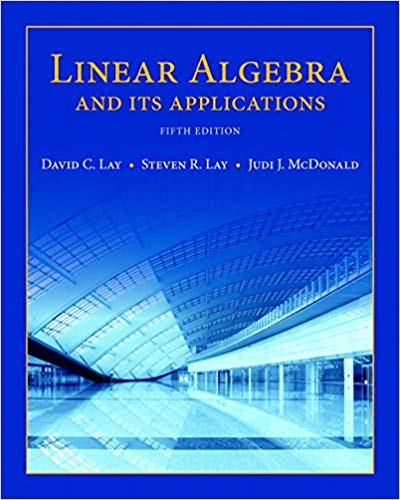
Linear Algebra and Its Applications, 5th Edition
Authors: David C. Lay, Steven R. Lay, Judi J. McDonald
ISBN-13: 978-0321982384
We have solutions for your book!
See our solution for Question 29E from Chapter 6.2 from Lay's Linear Algebra and Its Applications, 5th Edition.
Problem 29E
Chapter:
Problem:
Let U and V be n × n orthogonal matrices. Explain why UV is an orthogonal matrix. [That is, explain why UV is invertible and its inverse is (UV)T .]
Step-by-Step Solution
Given Information
We are given that U and V are $n \times n$ orthogonal matrices. We have to explain why UV is an orthogonal matrix.
Step-1:
By the definition of orthogonal matrix, a matrix A is said to be an orthogonal matrix if it is a square matrix such that. \[ A ^ { - 1 } = A ^ { T } \]
Step-2:
If U and V are two orthogonal matrices then \[ U ^ { - 1 } = U ^ { T } \text { and } V ^ { - 1 } = V ^ { T } \] Thus, \[ U ^ { T } U = U ^ { - 1 } U = I \text { and } V ^ { T } V = V ^ { - 1 } V = I \]
Step-3:
Since U and V are invertible, the product UV is also invertible. \[ \begin{aligned} ( U V ) ^ { - 1 } & = V ^ { - 1 } U ^ { - 1 } \\ & = V ^ { T } U ^ { T } \\ & = ( U V ) ^ { T } \end{aligned} \] Therefore,
UV is an orthogonal matrix
We are given that U and V are $n \times n$ orthogonal matrices. We have to explain why UV is an orthogonal matrix.
Step-1:
By the definition of orthogonal matrix, a matrix A is said to be an orthogonal matrix if it is a square matrix such that. \[ A ^ { - 1 } = A ^ { T } \]
Step-2:
If U and V are two orthogonal matrices then \[ U ^ { - 1 } = U ^ { T } \text { and } V ^ { - 1 } = V ^ { T } \] Thus, \[ U ^ { T } U = U ^ { - 1 } U = I \text { and } V ^ { T } V = V ^ { - 1 } V = I \]
Step-3:
Since U and V are invertible, the product UV is also invertible. \[ \begin{aligned} ( U V ) ^ { - 1 } & = V ^ { - 1 } U ^ { - 1 } \\ & = V ^ { T } U ^ { T } \\ & = ( U V ) ^ { T } \end{aligned} \] Therefore,
UV is an orthogonal matrix